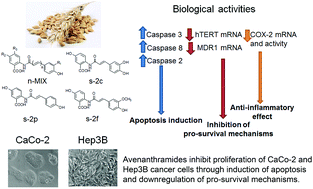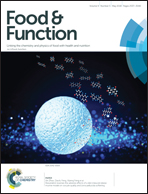Natural and synthetic avenanthramides activate caspases 2, 8, 3 and downregulate hTERT, MDR1 and COX-2 genes in CaCo-2 and Hep3B cancer cells†
Abstract
Avenanthramides (AVNs) are natural polyphenols obtained from oat sprouts and can also be chemically synthetized. The aim of the present study was to assess the anticancer, anti-inflammatory and antioxidant effects of individual synthetized AVNs (s-2c, s-2p, s-2f) and a natural AVN mixture (n-MIX) on CaCo-2 and Hep3B cancer cells. In CaCo-2, the AVN s-2c was found to be the most cytotoxic followed by the n-MIX. In Hep3B cells, a marked cytotoxic effect was found but no significant difference was observed between the synthesized AVNs and the n-MIX. In both CaCo-2 and Hep3B cells, natural and synthetic AVNs activated caspases 8 and 3, and the n-MIX and the AVN s-2c were also able to activate caspase 2. Both synthetic and natural AVNs downregulated pro-survival genes hTERT, COX-2 and MDR1, inhibited the activity of pro-inflammatory COX-2 enzyme and reduced prostaglandin E2 levels, showing the potent chemopreventive effects of these oat-derived phytochemicals. Synthetic AVN s-2c was found to have the highest chemical antioxidant capacity, as indicated by ORAC, DPPH and ABTS values, whereas all AVNs and n-MIX were shown to have similar intracellular antioxidant activity, evaluated by means of the DCFH-DA assay. As AVNs have high bioavailability in humans, results of this study suggest that oat-based foods, fortified with AVNs, could be an alternative to produce functional foods with anticancer, anti-inflammatory and antioxidant effects for health benefits.



 Please wait while we load your content...
Please wait while we load your content...